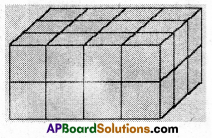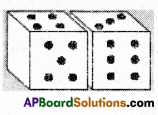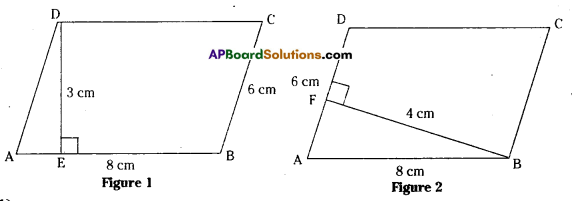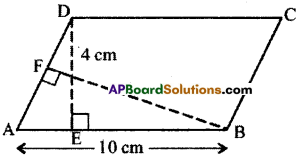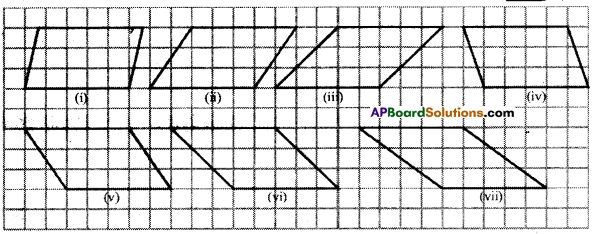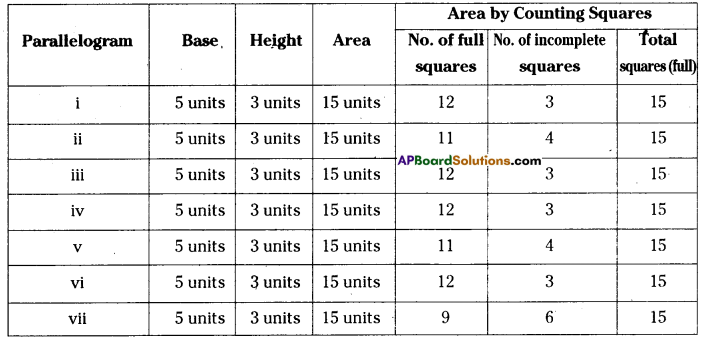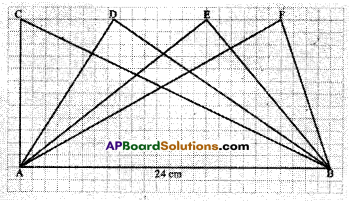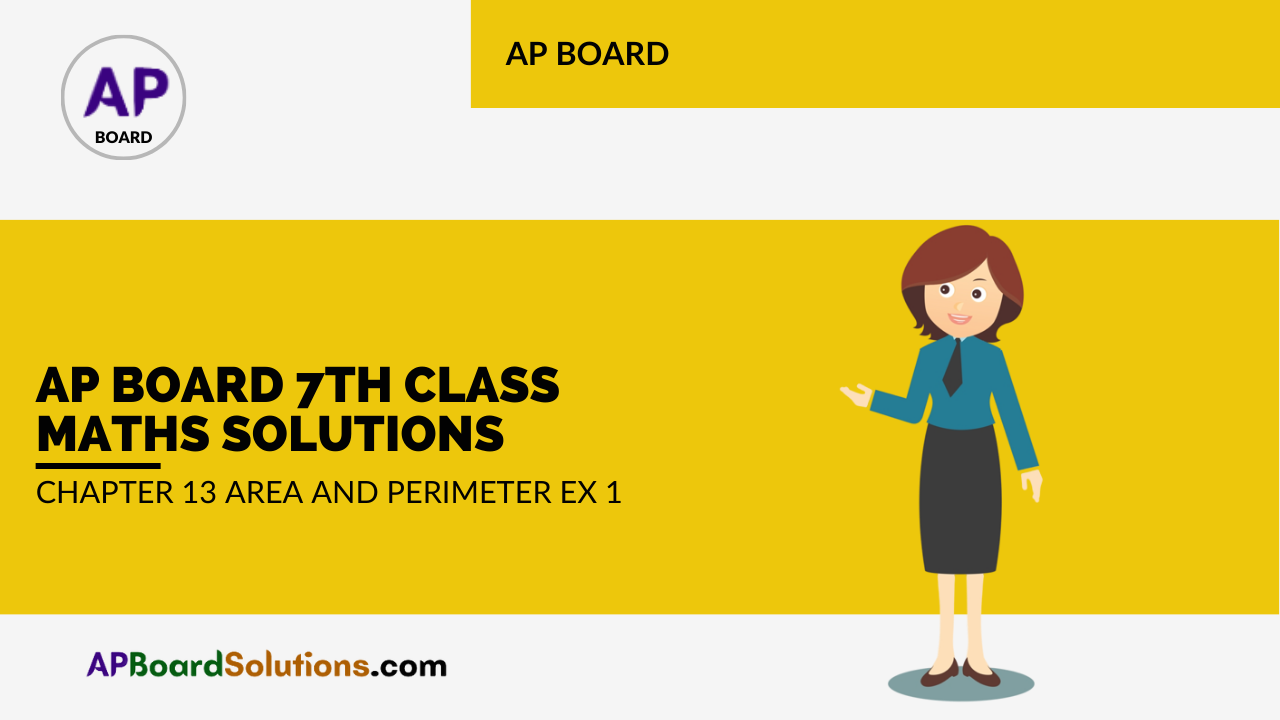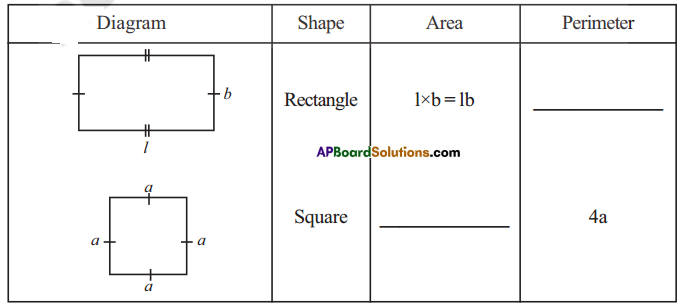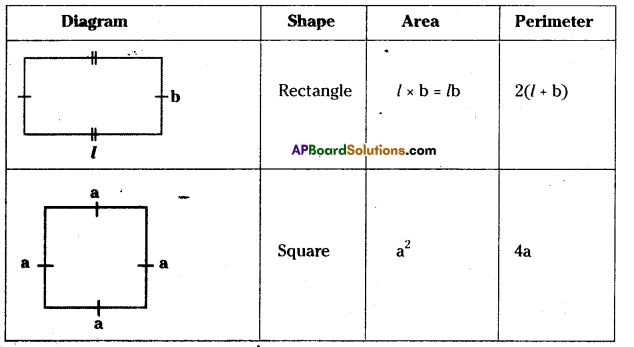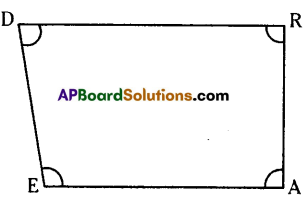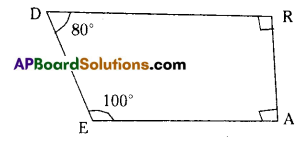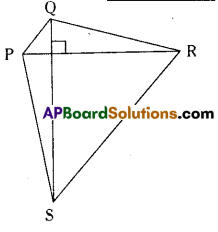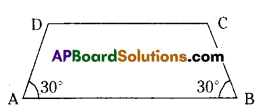AP State Syllabus AP Board 7th Class English Textbook Solutions Chapter 2A C.V. Raman, the Pride of India Textbook Questions and Answers.
AP State Syllabus 7th Class English Solutions Chapter 2A C.V. Raman, the Pride of India
7th Class English Chapter 2A C.V. Raman, the Pride of India Textbook Questions and Answers
Look at the pictures and answer the questions that follow.
Question 1.
Can you name these scientists?
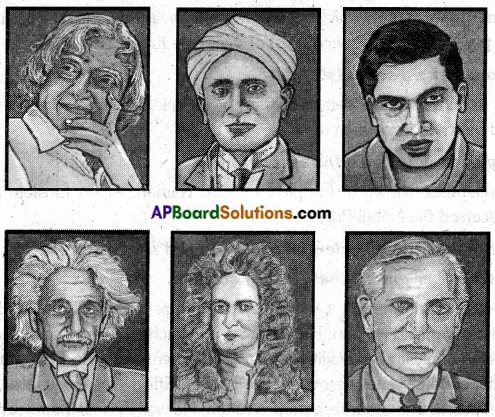
Answer:
- A.P.J. Abdul Kalam
- C.V. Raman
- Srinivasa Ramanujan
- Albert Einstein
- Isaac Newton
- Sir Alexander Fleming.

Question 2.
Tell your class what you know about them.
Answer:
- A.P.J. Abdul Kalam: He was the former President of India. He played a pivotal role in the development of Missile and Nuclear Weapons. He got Hoover medal. He is the recipient of Bharat Ratna award.
- C.V. Raman: He was the first Indian to receive the Nobel Prize in Physics for his ‘Raman Effect’. He was also the first Asian and the first non-white to receive the Nobel Prize. He discovered the Raman Effect with equipment worth only Rs. 200/- and limited facilities in his laboratory. He was the first Indian scholar who studied wholly in India.
- Srinivasa Ramanujan: He was a great Indian mathematician. He made extraordinary contributions to mathematical analysis, number theory and infinite series.
- Albert Einstein: He was a great German physicist. His Theory of Relativity showed that mass and energy are different forms of each other.
- Isaac Newton: He discovered that sunlight is a mixture of the colours of a rainbow. He built a telescope through which he saw the moons of Jupiter. He discovered the law of gravitational force.
- Sir Alexander Fleming: Sir Alexander Fleming was a Scottish biologist, pharmacologist and botanist. His best-known discoveries are the enzyme, lysozyme in 1923 and the antibiotic substance penicillin in 1928, for which he shared the Nobel Prize in Physiology or Medicine in 1999. It was a discovery that changed the course of history. The active ingredient in penicillin turned out to be an infection-fighting agent of enormous potency. When it was finally recognized for what it was, the most efficacious life-saving drug in the world, penicillin would alter forever the treatment of bacterial infections.
Question 3.
Are scientists special people? How?
Answer:
Yes, they are special in their attire, appearance and their thoughts. They neither know well of politics nor play them. They spend most of their time in scientific research.
Question 4.
Do you want to be a scientist? Why?
Answer:
Yes, I want to be a scientist. I am very fond of the science subject. I want to do research in physics and discover something new.
Question 5.
How many of them received the Nobel Prize?
Answer:
Of the six scientists shown in the pictures, C.V. Raman, Albert Einstein and Har Gobind Khorana received the Nobel Prize.

Question 6.
Who was the first Indian scientist that received the Nobel Prize?
Talk about him/her and his/her field of science.
Answer:
The first Indian scientist who received the Nobel Prize was C.V.Raman. His full name was Chandrasekhar Venkata Raman. He was born at Tiruchirapalli in Tamil Nadu on November 7,1888. He had only limited facilities and an equipment worth Rs. 200. Yet he worked hard, thought independently and discovered the Raman Effect which says that light changes its nature when passes through transparent medium. He was the first Indian scholar who studied wholly in India. He was the first Asian and also the first non-white to get the Nobel Prize. He was the pride of India.
He passed away in 1970 on November 21.
I. Answer the following questions.
Question 1.
Why was Raman happy when he learnt that Professor Compton had won the Nobel Prize?
Answer:
When Raman learnt that Professor Compton had won the Nobel Prize, he felt very happy because what Prof. Compton wanted to prove, was proved and Raman felt that he would also succeed in his effort.
Question 2.
What does the ‘Compton Effect’ tell us?
Answer:
The ‘Compton Effect’ tells us that the nature of X-rays changes when passed through the matter. The change was dependent on the kind of matter.
Question 3.
What was Raman’s advice to young scientists?
Answer:
C.V. Raman’s advice to young scientists was to look at the world around them and not to confine themselves to their laboratories. He said that the essence of science is independent thinking and hard work but not equipment.
Question 4.
Which paragraph tells about the ill-health of C.V.Raman?
Answer:
Paragraph No-7 in the lesson tells about the ill-health of C.V. Raman.
Question 5.
What was the challenging situation when Raman started his experiment on light?
Answer:
When Raman started his experiment on light, no sophisticate equipment was available in his laboratory. But he was confident he could do the discovery by making some modifications in his experiment. With equipment worth hardly Rs. 200 and limited facilities, Raman made the discovery.

Question 6.
What was the unseen force working behind Raman for reaching great heights?
Answer:
The unseen force working behind Raman for reaching great heights was his confidence, dedication and hard-work in what he tried to discover. His confidence was that he could discover with some modifications in his equipment and using the limited facilities made him very great.
Question 7.
What was ‘Raman Effect’?
Answer:
‘Raman Effect’ was that light changes its nature when passed through a transparent medium. It was his discovery of new radiation (describing the behaviour a beam of light passing through a liquid chemical).
Question 8.
If A.H. Compton had not discovered the ‘Compton Effect’, do you think Raman would have discovered the ‘Raman Effect’? Give your reasons.
Answer:
Yes, even if A.H. Compton had not the ‘Compton Effect’, Raman would have the Raman Effect because Raman was a very optimistic, well-confident and dedicated scientist. He was not a dependent on equipment. He was not confined himself to his laboratory. ,He had independent thinking and was hard-working.
Question 9.
In what way was Raman different from the other Indian scientists? List them and justify your answer.
Answer:
Other Indians want good and sophisticated equipment to carry out their experiment. They confine themselves to their laboratories. But C.V. Raman was not dependent on equipment. He had no sophisticated equipment. He did not confine himself to his laboratory. Unlike others, he was hard-working and confident and had independent thinking and looked at the world around him.

Question 10.
If you were a scientist, what would you like to invent/discover?
Answer:
If I were a scientist, I would like to invent a car that could run with the energy of sunlight but not with diesel or petrol.
II. Say whether the following statements are true or false. Correct the false statements.
1. C.V. Raman was born in Calcutta. ( )
2. The Compton Effect was a discovery made by C.V.Raman. ( )
3. Raman’s mother was a college physics teacher. ( )
4. Raman was an average student at school. ( )
5. Raman studied how the drum could produce music. ( )
6. Raman spent only two hundred rupees to win the Nobel Prize. ( )
7. Raman was only 42 when he won the Nobel Prize. ( )
Answer:
1. False
2. False
3. False
4. False
5. False
6. True
7. True
Correct Statements:
1. C.V. Raman was born in Tiruchirapalli.
2. The Compton Effect was a discovery made by Professor Compton.
3. Raman’s father was a college physics teacher.
4. Raman was a brilliant student at school.
5. Raman studied how the violin, etc. could produce music.

Vocabulary
I. The following sentences are from your lesson. Read them carefully and tick (✓) the correct meaning of the underlined word in each sentence.
1. His parents were keen to send him abroad for higher studies.
(a) particular
(b) eager
(c) worried
2. The world hailed the discovery as the ‘Raman Effect’.
(a) admired
(b) called
(c) thought
3. In his youth Raman was mainly interested in acoustics.
(a) primarily
(b) simply
(c) certainly
4. The British made Raman a knight of the British Empire.
(a) appointed
(b) managed
(c) placed
5. Raman passed awav on November 21, 1970.
(a) was killed
(b) died
(c) left
Answer:
1) b
2) a
3) a
4) a
5) b
II. Read the following sentence.
Raman was equally delighted.
The underlined word ‘delighted’ is a verb and has been used to express a feeling of joy or happiness. Its noun form is ‘delight. ’ Now look at the following verbs and write their corresponding noun forms.

Answer:
2) surprise
3) disappointment
4) worry
5) satisfaction

Now fill in the blanks with the suitable noun forms of the underlined words in each sentence. .
1. He was shocked to see a snake in his room but he recovered from his ——– in no time.
2. He pretended to look relieved but, in fact, he did not have any ——–.
3. I can understand your ——–. But do not be so excited that you have health problems.
4. Raju, an auto driver, was very honest. His ——– was known to everybody when he returned the bag of jewellery a passenger had left in his auto.
Answer:
1) shock
2) relief
3) excitement
4) honesty
III. (1) Read the following sentence and notice the underlined part.
Raman staged in the country to do the M.A. course.
The underlined letters in capitals denote an abbreviation. The full form of this abbreviation is ‘Master of Arts’.
Here is a list of some common abbreviation’s. Write their full forms.


Answer:
| Abbreviation |
Full form |
| B.A. |
Bachelor of Arts |
| A.D. |
Anno Domini |
| B.C. |
Before Christ |
| C.M. |
Chief Minister |
| C.D. |
Compact Disc |
| D.V.D. |
Digital Versatile Disc/ Digital Video Disc |
| a.m. |
ante meridiem |
| p.m. |
post meridiem |

(2) Read the following sentence and notice the underlined word.
He used to spend his hours after office in the lab.
The underlined word “lab is the short form of laboratory,”
Look at the following list of short forms and write their full forms. The first one is done for you. (Use a dictionary)
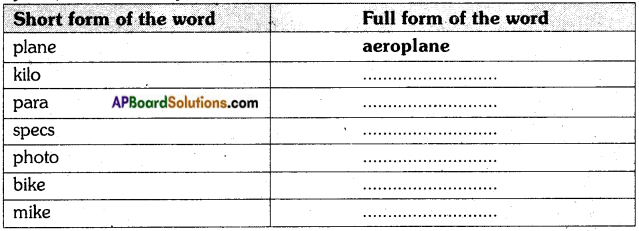
Answer:
| Short form of the word |
Full form of the word |
| plane |
aeroplane |
| kilo |
kilogram |
| para |
paragraph |
| specs |
spectacles |
| photo |
photograph |
| bike |
bicycle, motor bike |
| mike |
microphone |
IV. In the paragraph 4 you have learnt that ‘optics’ is the study of light. Do you know ‘ the word for the study of living beings? It is ‘biology’. It comes from ‘bio’ (means ‘life’) + ‘logus’ / ‘logy’ (means ‘study of science’). So the suffix ‘-logy’ adds the meaning ‘the study of’.
Guess the meaning of the words under Column A and match them with the phrases under Column B.

Answer:
1) d
2) e
3) a
4) c
5) b

Grammar
I. Read the following sentences from your lesson and observe how the underlined words are used before dates, years and the names of places.
1. Raman was born on November 7,1888. (Para 6)
2. Raman passed away in 1970 on November 21. (Paral 11)
3. Raman did his M.A. course at Presidency College in Madras. (Para 6)
4. In December, on a fine evening in 1927, there was much excitement. (Para 1)
Note: ‘on’, ‘in’ and ‘at’ are prepositions of time and place. In sentence 1 & 2 ‘on’ is used before a date. In sentence 2, 3 & 4 ‘in’ is used before a year (in 1970), before the name of a big city (in Madras) and before the name of a month (In December). In sentence 3 ‘at’ is used before the name of a small place / area.
Now fill in the blanks with ‘in, ‘on’ and ‘at’.
Sarath Chandra and Keerthana are brother and sister. Sarath Chandra was born –1– 25th April –2– 2000. Keerthana was born –3– December 2, 2001. They are with their parents. They live –4– Kondamudusu Palem, a small village –5– Prakasam District. They play games –6– school. It is usually very hot –7– May –8– their village. So they spend their summer –9– Hyderabad –10– their uncle’s house. Mr. Srisailam is their uncle. He resides –11– High Court Colony –12– Hyderabad with his wife, Jagadeeswari and his daughter, Vishnu Priya.
Answer:
1) on
2) in
3) on
4) at
5) in
6) at
7) in
8) in
9) in
10) at
11) at
12) in
II. Revision of ‘Articles’.
1. ’a’ is used before singular common nouns /in nouns phrases beginning with consonant sounds.
2. ‘an’ is used before singular common nouns / in noun phrases beginning with vowel sounds.
3. ‘the’ is used
(a) before words/phrases that indicate unique things (“It was the headquarters of the Indian Association ‘)
(b) in situations where the sentence itself contains a clue to identify of the thing or the person referred to (e.g. His advice to young scientists was also to .look at the world around them)
(c) in social situations where the identity, of the person / object is understood (“But look here, Krishnan,” he said turning to the young man ..”).
d) before the names of musical instruments (“He studied how stringed instruments like the violin “)
III. List 20 phrases from the text that begin with ‘a’/ ‘an’ or ‘the’. Then put 1,2,3(a), 3(b), 3(c), or 3(d) against them depending on how ‘a’ / ‘an’ or ‘the’ is used. One is done for you.
1. an old building 2
2. It was the headquarters of the Indian Association. 3(a), 3(a)
3. Raman said turning to the young man. 3(c)
4. His advice to them was to look at the world. 3(b)
5. He studied how the violin 3(d)
6. He was the firsts Indian 3(a)
7. The British Govt. 3(a)
8. The day on which he discovered. 3(b)
9. Raman had already made an impression. 2
10. a British surgeon 1
11. a college physics teacher 1
12. Raman was able to make a discovery. 1
13. On the busy Bowbazaar Street 3(b)
14. Raman stayed in the country. 3(b)
15. passing through a liquid 1
16. the nature of X-rays . 3(a)
17. passed through a transparent medium 1
18. That was the question that Raman asked 3(c)
19. Optics, the science of light 3(a)
20. It was a high honour 1

Now fill in the blanks with ‘a’ ‘an’ or ‘the’.
1. In 1987 M.S. Swaminathan was awarded ——– Ramon Magsaysay Award.
2. We dined yesterday at ——– Maurya Sherton hotel.
3. Tejaswini lent me ——– interesting book.
4. My father is ——– school teacher.
5. M.S.Swaminathan worked at ——– Indian Agricultural Research Institute.
6. Rekha bought ——– long notebook yesterday.
7. Sravani is eating ——– mango now.
8. Ganesh always carries ——– umbrella with him.
9. Rambabu is ——– English teacher in a high school.
10. Manjula and Sruthi play ——– guitar well.
Answer:
1) the
2) the
3) an
4) a
5) the
6) a
7) a
8) an
9) an
10) the
Writing
I. Write a paragraph on J.C. Bose using the hints given below. You must use the right linkers to join the sentences.
J.C. Bose – Indian scientist – born 30-09-1858 – St. Xavier’s School, Calcutta – abroad for higher studies – returned in 1885 – published a monograph, Response in the Living and Non-living – became famous – Fellow of the Royal Society in 1920 – wireless telegraphy in 1895 – the Crescograph – plants have life – the Bose Institute in Calcutta – devoted to the study of plants – died 23-11-1937.
Share your draft with your partner and refine your draft in the light of the suggestions offered by him.
Answer:
Jagadish Chandra Bose (J.C. Bose) was a famous Indian scientist. He was born on 30th September, 1858.
J.C. Bose studied at St. Xavier’s School in Calcutta. Later he went abroad for higher studies. He returned to India in 1885. He published a monograph which was about the response in the living and the non-living. He became famous by being a Fellow of the Royal Society in 1920.
J.C. Bose invented wireless telegraphy in 1895. He proved that plants have life. J.C. Bose invented Crescograph, an instrument with which the growth in plants can be known.
J.C. Bose founded the Bose Institute in Calcutta. He devoted most of his life to the study of plants. J.C. Bose passed away on 23rd November, 1937.

II. The passage given below has some errors in the use of capital letters, verbs, prepositions and articles. Edit the passage by underlining the incorrect parts and writing them correctly over the space available. The first one is done for you.
Raman was borne (born) on November 7, 1888, in tiruchirapalli at tamil nadu. He finishes his m.a. course at Presidency college in chennai. He became member of the indian association for cultivation of science. He took up a administrative job in the finance ministry in Calcutta. He was elected the royal society of London in 1924 and the british government made him a knight of the british empire in 1929. He was first indian scholar who studied wholly in india and received the nobel prize.
Answer:
The incorrect parts in the given passage have been underlined. Given below is the passage with no incorrect parts.
Raman was born on November 7, 1888 at Tiruchirapalli in Tamil Nadu. He finished his M.A. course at Presidency College in Chennai. He became a member of the Indian Association for Cultivation of Science. He took up an administrative job in the Finance Ministry in Calcutta. He was elected to the Royal Society of London in 1924 and the British Government made him a knight of the British Empire in 1929. He was the first Indian scholar who studied wholly in India and received the Nobel Prize.
Study Skills
I. Study the pie charts and answer the questions given below them.
Distribution of Weight in Human Body.

1. Which of the following constitute most of the weight in the human body?
(a) water (b) proteins (c) dry elements (d) bones
Answer:
(a) water
2. Which of the following statements is correct?
(a) Proteins constitute 11 per cent of the human body.
(b) Dry elements constitute 15 per cent of the human body.
(c) Hormones, enzymes and other proteins constitute 2/5 of the human body.
Answer:
(c) Hormones, enzymes and other proteins constitute 2/5 of the human body.
3. If a person’s weight is 100 kilograms, how much do his bones weigh?
Answer:
20 Kgs
4. If the proteins in a person weigh 12 kilograms, what will be his weight?
Answer:
50 Kgs
5. Are the bones in our body heavier than the water in our body? Support your answer.
Answer:
No, they are not. Water constitutes 65 per cent of our weight.

Listening and Speaking
Your teacher will read the passage “The Inventor of Inventors’. Listen carefully and answer the questions given below.
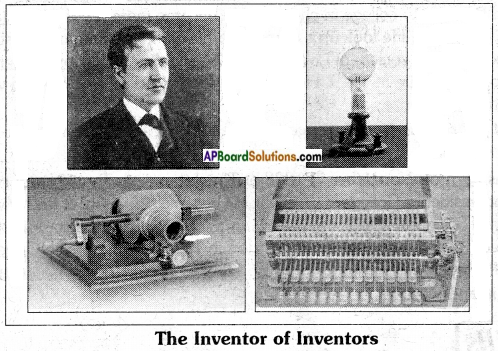
Genius is one percent inspiration and ninety-nine percent perspiration.’ -Thomas Alva Edison
Thomas Alva Edison, the greatest inventor of all times, is the most suitable example of his own saying. This great, outstanding US inventor had the credit of making 1001 inventions. Can you imagine a world without electric light, recorded music, cinema, etc. which are the contributions of this great genius?
Edison was born on February 11, 1847 at Milan, Ohio. His father was in-charge of a light house at Lake Huron. Although he could not continue his studies in his school, he was very inquisitive from his boyhood to learn by understanding. When he was only ten years old, he set up a laboratory in the basement of his father’s work place. He loved to mix liquids and powders to observe the reactions.
At the age of 12, he began selling newspapers and candy in trains. As a very keen observer, he learnt some preliminary techniques of telegraphy from the station master, which led him later to work as a roving telegrapher. During his stint as a supervisor in a Telegraph company, he created a stock printer. With the money received from it, he set up a laboratory for carrying out his experiments and research work. In subsequent years he invented phonograph — the machine for recording and reproducing sound. Edison thus made man’s voice immortal. In 1878. he demonstrated the light bulb — a carbon filament electric bulb.
While experimenting on electric lamp, he discovered an important scientific principle known as ‘Edison Effect’. This discovery led to the invention of electron valves and the modern electronics industry rests on this principle. In 1882, he set up a power generating station which supplied power to a few residents of New York City. Later, he developed the kinetograph which was the first step towards motion picture camera. Cinema houses are here today because of the inventive genius of Edison. His other inventions include the spheres of X-rays, telephone and other electronic items. His inventions made him one of the richest men in America.
This great genius passed away on 18 October, 1931.

I. Say whether the following statements are true or false.
1. When Edison was twelve, he established a school. ( )
2. Edison discovered an important scientific principle known as the Edison Effect. ( )
3. Edison was a poor observer. ( )
4. Edison’s father was a school teacher. ( )
5. Edison loved to mix liquids and powders to observe the reaction. ( )
Answer:
1. False
2. True
3. False
4. False
5. True
Here is a list of inventions. Put a ( ✓)against them if it was invented by Edison.
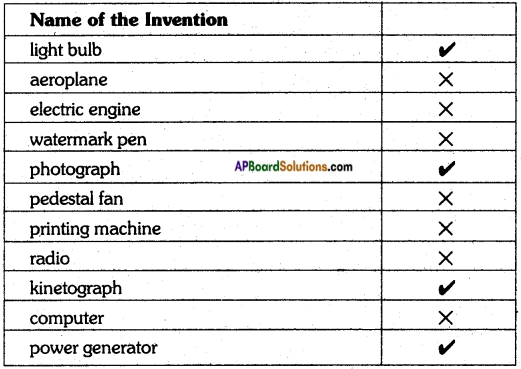
III. GROUP WORK
1. Thomas Alva Edison invented electric bulb. If there were no electric bulbs, how would be our life?
Mother: What are you doing Ramu?
Ramu: Nothing mom!
Mother: Why aren’t you doing anything my boy? Tomorrow you’ve a terminal exam.
Ramu: How can I read mom? The power has gone.
Mother: Why? You can read under a kerosene lamp or under a candle.
Ramu: Kerosene lamp gives out a lot of smoke. It smells bad. More than that, the smoke may cause irritation to my eyes.
Grandmother: So! You can’t use the oil lamp for at least an hour. That too in emergency! But we’ve struggled all our lives with them.
Ramu: That is your fate ! But today we are all comfortable with electric bulbs.
Mother: If there were no electric bulbs, what would be our lives ?
Ramu: I can’t imagine ! Damn the dark world ! We are not supposed to live in darkness. At night we would be blind and were to grope for everything in darkness. There will be no progress in human life. Life comes to a standstill. We have to go back to the middle ages. Thank God ! Thomas Alwa Edison was born hundred and seventy five years ago and invented the electric bulb.
[Just then power comes and brighten the whole city with its splendid and gorgeous lights.] Thank you Edison ! We are always very much grateful to you. Now mom, I am going to read my lessons.

2. Debate the following proposition :
‘Science has proved to be more a curse than a blessing.’ Divide the groups into two sets. One set of students speak in favour of the motion and the other against it. They may use the words / expressions listed in the box.

Conversation
Answer:
‘A’ – At the outset, I would like to emphasise that it is not science that has proved to be more a curse than a blessing but its use by selfish man that has proved to be a real curse.
‘B’ – May I begin by saying that unless there is something wrong in science itself, it cannot be abused. Hence science is a curse.
‘C’ – I must take strong exception to what ‘B’ has said. Even a very useful product may be abused because of either lack of proper knowledge or malintention.
‘D’ – Whatever may be one’s views, I must add that science is definitely a blessing. But no blessing comes to us with 100% positive uses. We must learn to use the positive side of it and ignore the negative side. That’s how wise people use science.
‘E’ – We may conclude with supporting “D’. We must all work hard to minimize the evil results of science and maximise its good effects. Then there wouldn’t be any scope for sayings like ‘Science is a more a bane than a boon’.
IV. Listen to the conversation between Sindhu and Mary.
Sindhu: Mary, where have you been all the week?
Mary: Um…I had been to Hyderabad.
Sindhu: Hyderabad? Why? Why did you go there?
Mary: You know, my uncle lives there. I went there to visit him.
Sindhu: That’s nice. But did you visit any place?
Mary: Oh!Yes, I visited a museum . It’s wonderful.
Sindhu: Really! What kind of museum is it?
Mary: It’s a science museum.
Sindhu: Science museum? But it should be boring.
Mary: Not a bit. I learnt a lot about many interesting things. You must see it.
Sindhu: Is it that much interesting? Could you tell me something more about it?
Mary: Oh! It takes a long time. Now I am in a hurry. I will talk about it later.

Now work with your partner and ask and answer questions about the science fair that might have been organised in your school or district. Use the following questions too.
1. When did you go to the science fair?
2. What things did you see there?
3. Which was the most interesting thing you noticed there?
Answer:
Vlnod: Hi, Santosh. You haven’t been seen these days;
Santosh: Hi, Vinod. Ya I had been to Khammam.
Vlnod: Why? What is the purpose?
Santosh: Don’t you know that a science fair has been going on there?
Vlnod: A science fair? No, I don’t know about it. When did you go there?
Santosh: Vinod, our science teacher told us about It last Saturday. I went there on Sunday.
Vlnod: Oh! I didn’t come to school on Saturday. Any way, what did you see there?
Santosh: I saw a lot many exhibits. It took two full days for me to just go round the stalls.
Vinod: OK. Then just tell me about the most interesting thing you saw there.
Santosh: The exhibit on conservation of water impressed me a lot. May be because
I am interested in the subject.
Vinod: How long will the science fair be open, Santosh? I too feel like visiting it.
Santosh: It will be open, till the day after tomorrow.
Vinoid: Then I will start for Khammam today itself. Bye Santosh!
C.V. Raman, the Pride of India Summary in English
Chandrasekhar Venkata Raman was an eminent Indian Scientist. He was the first scholar who studied wholly in India. He was the first Indian Scientist to receive the Nobel Prize in Physics. He was also the first Asian as well as the first non-white to receive the Nobel Prize.
C. V. Raman was born at Tiruchirapalli in Tamil Nadu on November 7, 1888. His father was a college physics teacher. Right from the start, Raman was a brilliant student. So, when Raman passed his matriculation, his parents wanted to send him abroad for higher studies. But a British surgeon told them not to send him abroad as he was not healthy enough. Raman did his M.A. course at Presidency College in Madras (now called Chennai).
Raman was fond of the Science subject. When he was 19, he became a member of the Indian Association for Cultivation of Science. The headquarters of it was an old building on the busy Bowbazaar Street in Calcutta. Meanwhile Raman took up an administrative job in the Finance Ministry in Calcutta so as to respect the wishes of his parents.
In his youth, Raman was mainly interested in acoustics, the science of sound. He studied how stringed instruments like the sitar and the violin could produce harmonious music. He became a knight of the British Empire in 1929.
With equipment worth only Rs. 200 and limited facilities available in his laboratory, Raman was able to make a discovery known as the Raman Effect, which won him the Nobel Prize in physics in 1930. Earlier, in 1927, Professor A.H. Compton had won the Nobel Prize for the Compton Effect. Compton Effect says that the nature of X-rays changes when passes through the matter. Raman Effect says that the nature of light changes when passes through transparent medium. Raman’s advice to the young scientists was to look at the world around them and not to confine themselves to their laboratories. Raman passed away in 1970 on November 21.
C.V. Raman, the Pride of India Glossary
lost in thought: giving all your attention to something so that you do not notice what is happening around you
transparent (adj): allowing you to see through it
sophisticated (adj): advanced and capable
equipment (n): the things that are needed for a particular activity
modification(n): change
discovery (n): the process of finding something that was not known about before
red-letter day (Idiom): an important day
surgeon (n): a doctor who is trained to perform surgery

abroad (adv): in or to a foreign country
flag (v): decline, become less
stringed Instrument (n): any musical instrument with strings (eg. the violin, the sitar etc.)
harmonious (adj): very pleasant
knight (n): a man of high social rank a person with the title
confine (v): to restrict
received (v): got
passed away (v): died
remarkable (ad)): memorable
mainly (adv): primarily
keen (adj): eager
hailed (v): admired
made (v): placed
![]()
![]()


![]()


![]()
![]()












